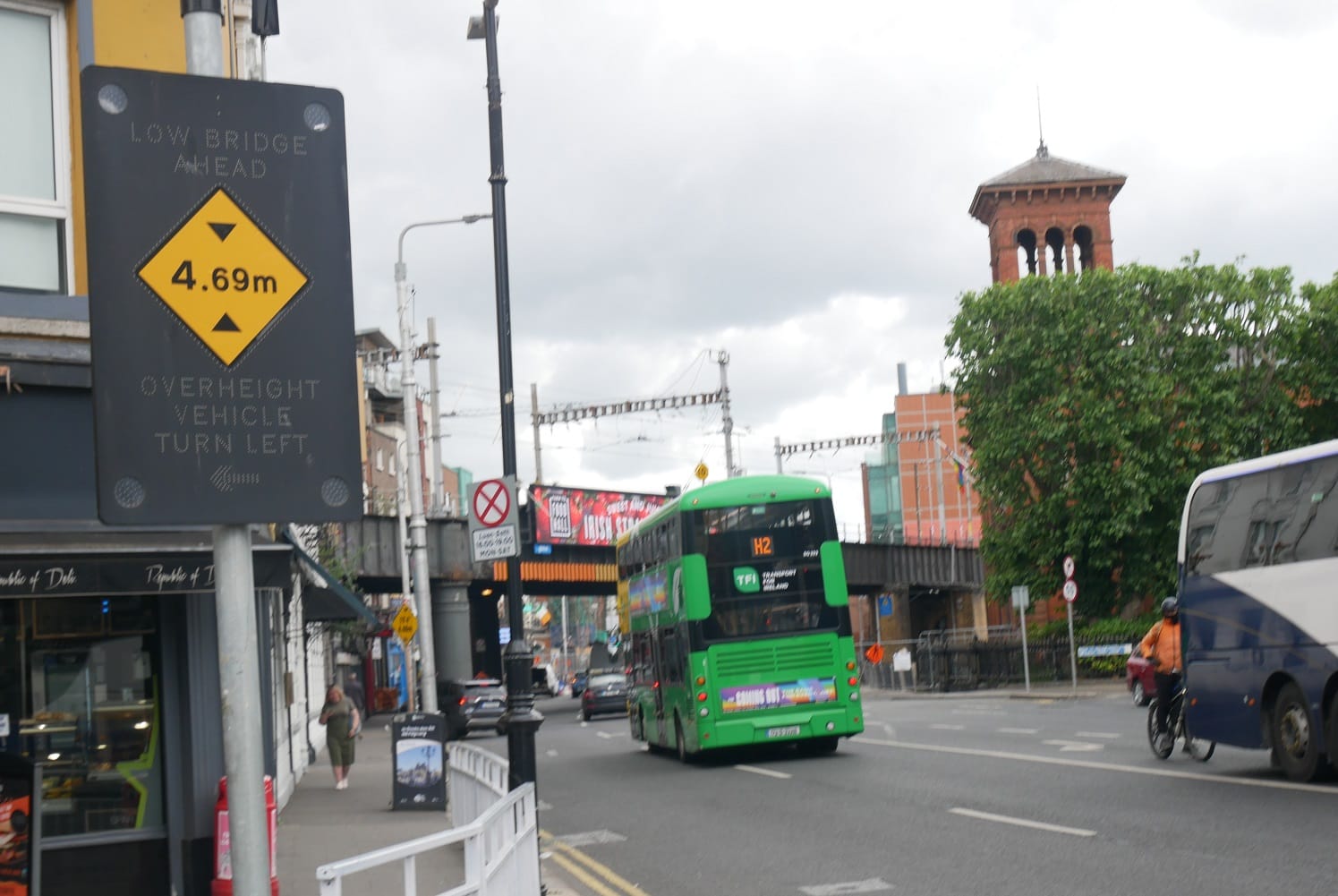Did the council follow the correct process to name Herzog Park back in 1995?
Or has Rathgar been living with Orwell Quarry Park all this time?
What more can be done to keep drivers from trying to squeeze their trucks and coaches under too-low railway bridges, causing safety risks, damage and delays?

Trucks and coaches hit the railway bridge passing over South Lotts Road regularly, says Geraldine Linney, folding clothes behind the counter of Whitewash Laundry.
The bridge, which the Dart passes over, is in Beggar’s Bush, only about 50 metres east of where Linney works.
“We just hear the bang and go out,” she says. “You just comment, ‘Feckin eejit.’”
Sometimes it’s private coaches that get stuck, she says. Sometimes it’s a cement truck, or one of those trucks with the big mechanical arm on the back for loading and unloading stuff.
Every once in a while, the guards come and let the air out of the tyres to help get the vehicle unstuck, she says.
Of all the railway bridges in the country, in the past five years, this one on South Lotts Road has been hit the second most times, according to Irish Rail. There are two others in Co. Dublin in its top 10 as well.
Vehicles hitting railway bridges are a “very significant” safety risk for the railway system, an Irish Rail spokesperson said.
When it happens, the driver is supposed to call the number on the bridge. Then the procedure is that Irish Rail stops the trains going over and an engineer goes to inspect it to ensure it’s still structurally sound, the spokesperson said.
Meanwhile, people trying to get somewhere via a train that goes over that bridge are left waiting. Or, as Irish Rail’s Twitter account put it Thursday: “Reckless driving by three #dumbtruckers causing delays up to 30 mins.”
This has immediate knock-on effects on people’s lives, of course. And there are ripple effects throughout the day, says Mark Gleeson, treasurer of Rail Users Ireland.
“Trains are stopped and this results in delays and puts trains in the wrong place later on in the day which results in more delays and overcrowding,” he says.
Bridge strikes and the delays they cause have longer-term impacts. When people view public transport as unreliable, they’re more likely to drive cars instead, which means more pollution, more congestion, more carbon emissions.
The bridge over South Lotts Road has been hit 24 times over the past five years, according to Irish Rail, the second highest number for any bridge in the country during that period.
The real number is probably higher, though, says Linney, in Whitewash.

Anthony Lee and Paul Cunningham, who work in the food shop Lotts & Co, which is practically under the bridge, say the same.
On Thursday morning, they are wearing white shirts and black aprons that say “F.X. Buckley”, and working behind the butcher’s counter.
“It’s hit at least once a month,” says Lee.
“It’s hit more than once a month,” says Cunningham. “Buses hit it at least once every two weeks and then reverse out.”
There are scrapes and bangs at the front edges of the bridge.
Aside from the South Lotts bridge (UBR60), there are two others in Co. Dublin on the top 10 list from Irish Rail.
The list includes UBB25, which goes over the R124 between Malahide and Portmarnock. That one’s in fourth place, with 18 strikes reported in the past five years.
(Although, a spokesperson for Fingal County Council said it had only been struck three times in the past six years.)
And there’s also UBB29, which goes over Strand Street in Malahide itself. That one’s in a three-way tie for seventh place, with 10 strikes reported in the past five years, according to Irish Rail.

All in all, bridge strikes caused 2,746 minutes of train delays in Dublin’s Dart and commuter area in 2022, an Irish Rail spokesperson said.
“Our claims department pursue road users for costs, when a bridge is struck. Separately, the Gardaí pursue road traffic prosecutions against people who hit bridges,” she said.
The main reason drivers keep running their vehicles into railway bridges is sat navs, says Eugene Drennan, president of the Irish Road Haulage Association.
There’s a European standard for bridges, and a European standard for trucks that’ll fit under them, he says. But there’s old bridges that don’t meet this, and vehicles that aren’t standard too.
The driver who hits a bridge probably doesn’t know the area, they’re just following the directions their little robot helper is giving them.
They might be listening to the radio, or even talking or texting on their phone.
And the streets are crowded with signs to read, Drennan says. “It’s impossible to take it all in,” he says, and if the driver’s English isn’t great, that can make it even harder.
So the driver might miss the bright yellow stripes and the “LOW BRIDGE” sign, and the sign with the height of the truck that can fit under, Drennan says.
The person who drives their vehicle into the bridge is obviously the one responsible, but the “curator of the bridge” could be doing more to help too.
Fingal County Council and Irish Rail “have taken all available precautions to prevent bridge strikes” on the bridges in its area, a spokesperson for the council said.
“To reduce the risk of bridge strikes in the Fingal Administrative area, the Council ensures that all vulnerable low bridges have advance signage provided to show the height of the restricted headroom,” the spokesperson said.
“In addition there is warning signage provided before the ‘point of no return’. It gives HGV drivers an opportunity to divert to another route to avoid the low bridge,” he said.
“The strikes were not caused by advance warning signage but by HGV [heavy-goods vehicle] driver error,” he said.
There are ways to keep drivers from hitting railway bridges.
Drennan, as well as the Irish Rail spokesperson, and Gleeson, of Rail Users Ireland, all pointed to a specific success story.
In 2020, Irish Rail installed systems on Amiens Street north and south of the bridge going over it to Connolly Station, which can sense how high a vehicle is.
If it’s too tall to fit under the bridge, there are signs that’ll flash to alert them of the problem.
“We have not had one collision since it was installed in 2020, but we had lots of activations of the technology”, the Irish Rail spokesperson said.
Irish Rail, funded by the National Transport Authority, would pay for this kind of system. It would be installed in cooperation with the local authority, she said.

There are plans to install this type of system at two bridges in Portlaoise that are on the top 10 list. But no plans to install them at the bridges in Co. Dublin on the top 10 list, she said.
“These Dublin bridges are not suitable for this type of system, because there are many approach options and the signage would have to be so far back, it would be confusing for drivers as they may have no intention of going near the bridge,” she said.
Later, she said, “We are not against looking at installing this technology at other bridges including these ones, but our focus is on the bridges in Portlaoise at present as they are seen to have a great risk.”
Gleeson, of the Rail Users Ireland, also raised space as an issue. “This solution does need space to ensure the driver is told in time and at South Lotts road this isn’t really possible.”
Linney, who works at Whitewash Laundry in Beggar’s Bush, says that most drivers who hit the bridge over South Lotts Road hit it coming from the east.
There’s only one approach road coming from that direction, and there’s a sign there alerting drivers to the height of the upcoming bridge.
It’s unclear why that sign couldn’t be swapped out for a height sensor and flashing alert like the one on Amiens Street.
“The issue then is everytime the Tesco gets a delivery it would set it off,” says Gleeson, as trucks not planning to go under the bridge drove into the car park at the Tesco just before the bridge.
“We can do better than current and that does require the cooperation of the local authority as it’s beyond Irish Rail property,” he said.
If installing sensing-flashing signs isn’t the best option, there are other ones too.
The simplest, Drennan of the Irish Haulage Association, says is to install a plastic bar the same height as the bridge a distance in front of it.
Even if the driver misses all the signage telling them there’s a low bridge coming and how high it is, if their bus or truck hits the plastic bar, they’ll notice, he says.
And the bar would be relatively cheap and light and easy to replace if necessary.
Gleeson, of Rail Users Ireland, suggests something similar.
“The physical engineering solution is a bash beam,” he says. “This is a steel beam placed in front of the bridge at the same height as the bridge. The idea being any over-height vehicle hits the beam first and does not damage the bridge.”
“This does require some space and can be ugly,” he said. “It’s not an option for South Lotts Road as there isn’t space available. It’s great out in the countryside but otherwise can be tricky to get installed.”
Another possibility is getting all the sat nav and mapping services to add bridge heights to their maps.
A new EU law has recently been agreed that obliges these types of companies to listen more to what local governments ask them to do.
At the moment, the companies and the local governments are talking to each other at a European platform called NAPCORE about the details of implementing the law.
It’s due to come into force in a staged way between 2025 and 2027.
What about a system where the sat nav system knows the bridge heights, and the driver enters their truck height, and if something’s going to go wrong, an alert goes off inside the cab of the truck?
“The problem with a truck is the trailer height, that will vary while the cab itself is a fixed height,” said Gleeson, of Rail Users Ireland.
“Better education, better GPS tools which take height into account are valuable but ultimately physical measures will always be needed as a final step,” he said.
Could Amiens Street-style sensing-flashing signs work at the two top 10 bridges in Fingal?
A spokesperson for Fingal County Council said that was a matter for Irish Rail. The council has already done all it can, he said.
“There are no additional measures that Fingal County Council can implement to prevent bridge strikes at the location,” he said.
“Again, it is the responsibility of drivers to pay attention to and heed the advance warning signage installed on the approaches to the bridge,” he said.
A spokesperson for Dublin City Council did not respond to the same queries, sent 28 June, about the bridge over South Lotts Road.
Bridge strikes are the most common reason for train delays, said Gleeson, of Rail Users Ireland. “This is a big deal and the costs stack up,” he said.
Taking steps to protect bridges so they don’t get struck is worthwhile, he says, whether it’s sensing-flashing signs, or bash beams, or even “full engineering works to increase the clearance height”.